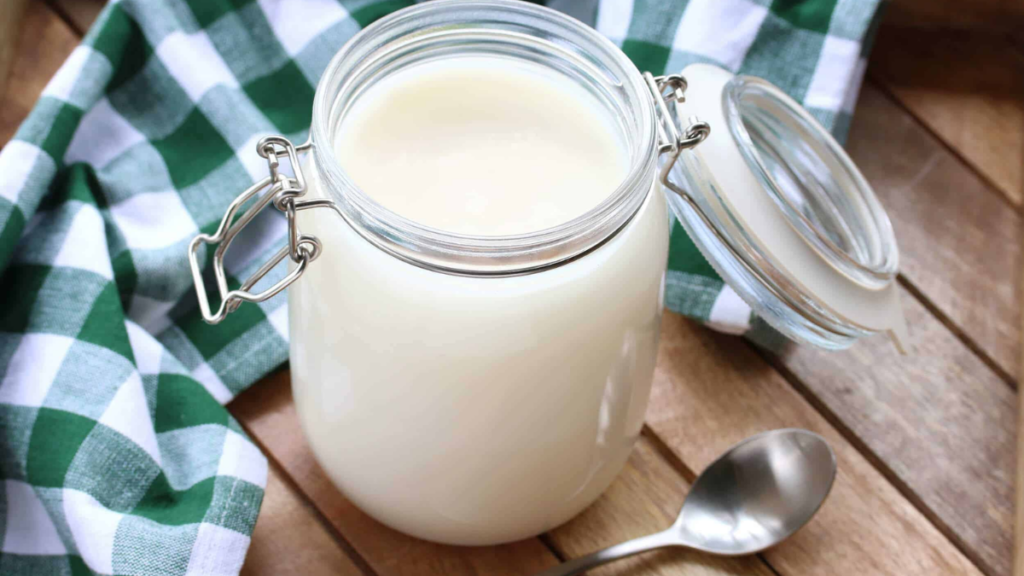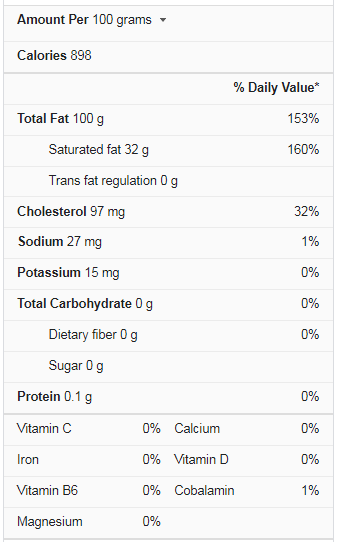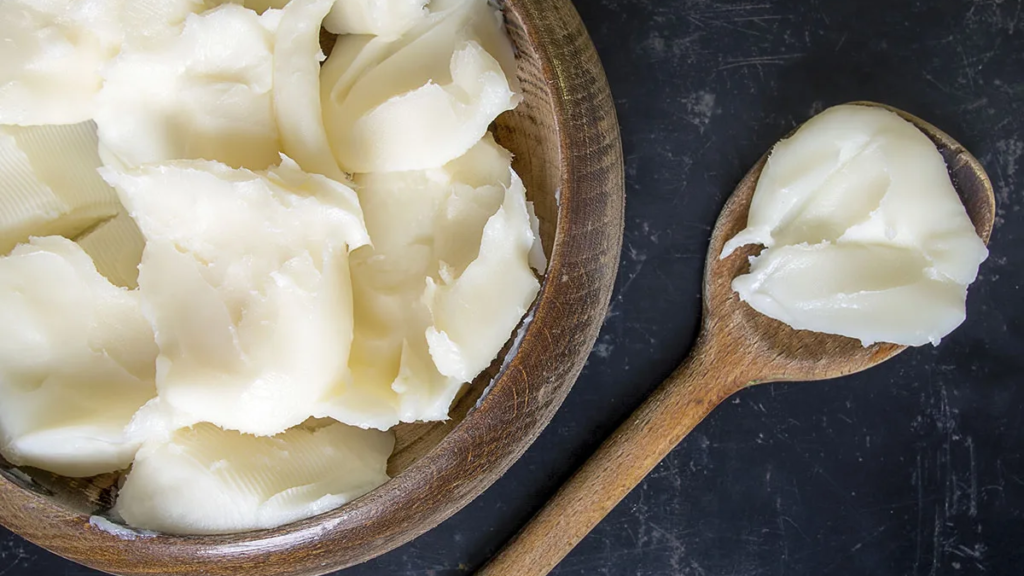Lard has long been used in pastry because it produces light, flaky pastries like pies. It can also be used as a cooking and frying fat for various purposes. In a process known as larding, lard is inserted into or wrapped around meats to baste them while they cook. High-quality varieties are flavorful but not overpowering, and they can be used in place of butter in recipes. Use about one-fifth less than the recipe calls for when using them as a butter substitute.
There are several grades to choose from. Leaf lard, which comes from the area around the pig’s kidneys, is the best. Back lard is also of high quality, whereas rendered fat from other pig parts is not. A wet or dry rendering process creates steam, or boiling fat produces wet lard. The fat will float to the top because it is not water-soluble, and the cook can skim it off. Dry rendering heats the fat in a large pan without water, allowing the cook to skim off any impurities.
Lard Nutrition Facts
What is Lard?
Lard is pig fat that has melted and is used in cooking, baking, and deep-frying. It has a creamy white color and a flavor that varies depending on the variety, brand, and how it’s made, from mildly porky to neutral, flavorless, and odorless.
- Rendered lard is pork fat that has been melted, filtered, and chilled.
- Processed lard has been melted, filtered, and then hydrogenated to make it shelf-stable.
- Leaf lard is made from the visceral fat encircles the pig’s kidneys and is considered the highest grade of lard. Its flavor is mild and un-porky, and it’s soft, creamy, and spreadable. And it’s particularly prized by bakers who love the flaky texture it imparts to pastries and other baked goods.
How to Cook with Lard?
Lard can be used in any recipe that calls for butter. As a result, you can use it in baking pies, cookies, biscuits, and pastries, as well as in making tamale masa. It’s also good for sautéing, rice and vegetable topping, and toast spread. However, lard serves a purpose that butter does not.
Lard, for example, is a popular deep-frying fat. It has a low smoke point, around 370 to 375 degrees Fahrenheit, but if you keep the temperature around 360 to 365 degrees Fahrenheit, it will produce crispy, flavorful fried chicken. It’s also a popular donut-frying fat. It’s worth noting that crispiness is determined more by the temperature of the fat and the type of battery used to coat the item.
However, when it comes to baking, lard’s unique properties aid in creating a more flaky crust or dough. This is because lard melts at a higher temperature than butter. The dough’s flakiness is due to fat lumps that form small pockets in the dough. When the dough is baked, the fat lumps eventually melt away, leaving the pockets intact and giving the dough a flaky texture.
And while the butter melts at around 90 to 95 degrees Fahrenheit, lard melts at temperatures ranging from 97 to 118 degrees Fahrenheit, which means the layers of dough stay separate for longer in the oven, resulting in more flakiness.
What does it Taste Like?
Different brands and types have different flavors depending on how lard is rendered. High-temperature rendering yields lard with a stronger pork flavor, whereas low-temperature rendering yields a tub of lard with a more neutral flavor. Furthermore, hydrogenated lard, the shelf-stable variety sold in supermarkets, has a firmer mouthfeel than freshly rendered lard, which is creamier, softer, and melts faster. Experimenting with different brands can help you distinguish between the two, especially if you don’t want your fruit pies to taste porky. Some people aren’t bothered by this, so it’s a personal choice.
What are the Uses of Lard?
Because of its high smoke point, lard is a versatile cooking fat (unlike other popular fats like butter). It’s worth noting, however, that because lard’s smoke point isn’t the highest of all fats, it’s not recommended for deep frying.
Lard is a flavorful fat that can be used to make savory dishes on its own. It can replace various fats in cooking and baking, and here are some ways to incorporate lard into your cooking.
Pie Crust
Lard imparts a distinct flavor to baked goods and pie crusts that other animal fats cannot match. The substance also produces a particularly flaky dough, according to bakers.
Cooking Eggs
By frying your eggs in lard, you can give your morning breakfast of eggs and toast a smoky, pork-like flavor.
Roasting Chicken Or Other Fowl
Use lard instead of butter to coat your chicken or turkey for a unique roast bird at your next family gathering.
Roasting Vegetables
You can take those boring roast vegetables up a notch by simmering your vegetables in lard rather than vegetable oils. Consider using pork fat to make side dishes to tie your meal together if you have pork for dinner.
Lard Substitute
There are a variety of fats that can be used in place of lard, and which one is best depends on the type of recipe you’re making. When frying, use vegetable shortening or a liquid oil like peanut oil, canola oil, or safflower oil. However, frying in butter or olive oil is not recommended due to their low smoke points. If you’re making a pie or biscuits, you could use butter or vegetable shortening instead of the shortening. Liquid oils won’t work because solid globs of fat create flaky layers in the pastry or biscuit dough.
The Difference Between Lard and Butter
Those who claim that lard is healthy fat like to compare it to butter because, on the whole, lard has a better nutritional profile than butter. Butter is a dairy product, whereas lard is animal fat. When the same amount of butter and lard are compared, butter contains more saturated fat and fewer omega-3 fatty acids. It’s important to remember that this is a very specific comparison. It is unlikely to win when the lard is compared to other fats and oils.
For example, it contains a lot more saturated fat than many vegetable oils. It’s all relative, and, as I’ve said before, it all depends on how much you use. Any amount of calorie-dense fat isn’t ideal in large quantities, and you wouldn’t feel well if you ate more than 100 apples. Similarly, consuming large amounts of animal or non—animal fat will not make you feel good.
Where to Buy Lard?
Most supermarkets sell processed lard, which comes in bricks or buckets, in the baking aisle alongside other shortenings such as vegetable shortening and cooking oils. Local butchers who render their own rendered lard are also a good source of rendered lard. Processed lard is hydrogenated to make it shelf-stable, which is trans fat. Lard rendered by a butcher, on the other hand, is 100% pork fat and thus no trans fat.
Storage
Shelf-stable lard from the supermarket can technically be kept in your pantry or cupboard at room temperature. In practice, however, this is largely dependent on the temperature of your pantry or cupboard. When the temperature in your kitchen rises above 75 degrees, your lard is more likely to go rancid. As a result, it’s best to keep it tightly sealed in the fridge or freezer. This is also true for butcher’s lard that has been freshly rendered.
Conclusion
The rendered or unrendered fat obtained from pigs is referred to as lard. Any part of a pig could be used to make it, and it could be done in the water by boiling or steaming it. Water or dry heat separates the insoluble fat from the water. It is not suitable for vegetarians because it comes from a pig. It’s used in a variety of dishes or as a butter substitute. It’s used in pates, sausages, and fillings, among other things. The fat content of the pig part used determines the quality of the lard. The best grade of lard is Leaf lard, and the second-best grade is Back lard. The two lar processes are wet and dry.



